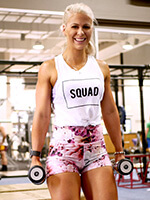The key to changing your body in the gym
Getting the results you want is as simple as continually challenging yourself, also known as progressive overload, explains The Fit Pharmacist, Holly Louise.
Have you been training for a while but are getting frustrated with your lack of results?
Do you find that you are just going through the motions at the gym and not really pushing yourself?
Lack of progressive overload is the main reason the majority of people who work out look the same today as they did when they first started training.
If you aren’t increasing the demands being placed on your body, you aren’t giving your body any reason to improve any further. Until the day you reach a point that you are happy with how your body looks and performs, your primary focus should be on progressive overload.
Progressive overload means continually increasing the demands on the musculoskeletal system in order to continually make gains in muscle size, strength and endurance.
In order to build muscle and get stronger you must progressively lift more and force your muscles to work harder than they are used to.
While consistent progression is essential to achieving results, it’s important to note that in order to achieve optimal progress, you need to make sure your form is never compromised and that you always feel your target muscle group working during an exercise.
Overload with resistance training can occur in a variety of ways:
Increasing the weight lifted
Progressively increase the weight you lift as you become stronger. A good indicator of when to increase the weight is when you are able to perform more than your target repetitions.
Increasing the number of reps per set
Increase the number of repetitions you perform for a given exercise to increase total volume.
Increasing the number of sets
Increase the number of sets you perform for a given exercise. Instead of 2 or 3 sets, increase to 3 or 4 in order to increase total volume.
Decreasing the rest time between sets
Decreasing the rest time between consecutive sets will force your body to adapt metabolically over time. This may also be beneficial for endurance athletes or individuals concerned with muscular endurance and cardiovascular fitness rather than gains in strength and power.
Increasing the intensity of the exercise
Increase your perceived exertion or how much effort you put into every set. This is essential for creating progressive overload.
Increasing range of motion
Many people do not use proper form when training. By utilising the full range of motion of an exercise, you can increase the difficulty of the exercise. Make sure you can perform all reps with strict form before you progress.
Increasing frequency of training
Increase how often you train a certain muscle or muscle group. This technique is often under utilised despite being extremely useful for improving weak muscle groups. The traditional approach of training a muscle or muscle group only once a week is usually not effective enough to make gains at the desired rate.
Obviously it would be impossible to continually increase your weights each session, but by manipulating just one, or more, of the above, you can increase your volume and continue to progress at the same time.
To make it easier to track your progression, it is important to keep a record of your workouts. You should make note of the exercises performed, the amount of sets and reps, the weight used, and total workout time. Other useful details may include the time of day, your energy levels or any other factors that may affect your performance, like hydration or nutrition.
If you are serious about building muscle and strength, you should also be in a calorie surplus. What this means is that you consume more calories than you burn each week, for an extended period of time. Tracking your food intake and workouts, along with your scale weight and measurements, plus taking progress photos, will give you the best indication of your progress and allow you to take your results to the next level.
If you have any further questions for Holly about progressing with your training, feel free to use our contact form.
 |
Holly Louise, aka The Fit Pharmacist, is a registered pharmacist, certified personal trainer, online coach and ambassador for INC Sports Nutrition. Through evidence-based nutrition and training methods, Holly Louise helps others create healthy and sustainable lifestyle change. Holly Louise is also a champion of flexible dieting and positive body image and has created a large community of women who support and empower each other to become their best selves.Find out more about Holly Louise on Instagram, Facebook and at The Fit Pharmacist. |






